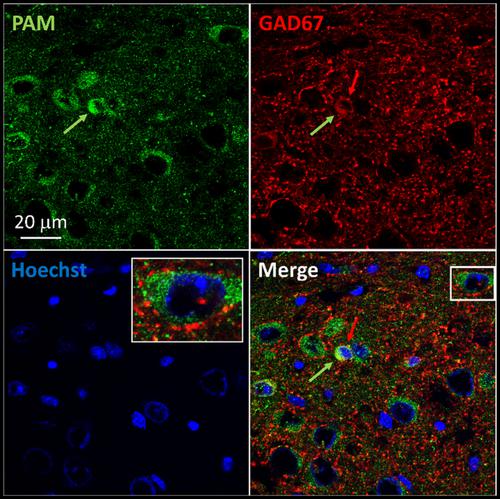当前位置:
X-MOL 学术
›
Genes Brain Behav.
›
论文详情
Our official English website, www.x-mol.net, welcomes your
feedback! (Note: you will need to create a separate account there.)
Cell‐type specific knockout of peptidylglycine α‐amidating monooxygenase reveals specific behavioral roles in excitatory forebrain neurons and cardiomyocytes
Genes, Brain and Behavior ( IF 2.4 ) Pub Date : 2020-09-09 , DOI: 10.1111/gbb.12699 Kathryn G Powers 1 , Xin-Ming Ma 1 , Betty A Eipper 1 , Richard E Mains 1
Genes, Brain and Behavior ( IF 2.4 ) Pub Date : 2020-09-09 , DOI: 10.1111/gbb.12699 Kathryn G Powers 1 , Xin-Ming Ma 1 , Betty A Eipper 1 , Richard E Mains 1
Affiliation

|
Neuropeptides and peptide hormones play a crucial role in integrating the many factors that affect physiologic and cognitive processes. The potency of many of these peptides requires an amidated amino acid at the C‐terminus; a single enzyme, peptidylglycine α‐amidating monooxygenase (PAM), catalyzes this modification. Anxiety‐like behavior is known to be altered in mice with a single functional Pam allele (Pam+/−) and in mice unable to express Pam in excitatory forebrain neurons (PamEmx1‐cKO/cKO) or in cardiomyocytes (PamMyh6‐cKO/cKO). Examination of PAM‐positive and glutamic acid decarboxylase 67 (GAD)‐positive cells in the amygdala of PamEmx1‐cKO/cKO mice demonstrated the absence of PAM in pyramidal neurons and its continued presence in GAD‐positive interneurons, suggestive of altered excitatory/inhibitory balance. Additional behavioral tests were used to search for functional alterations in these cell‐type specific knockout mice. PamEmx1‐cKO/cKO mice exhibited a less focused search pattern for the Barnes Maze escape hole than control or PamMyh6‐cKO/cKO mice. While wildtype mice favor interacting with novel objects as opposed to familiar objects, both PamEmx1‐cKO/cKO and PamMyh6‐cKO/cKO mice exhibited significantly less interest in the novel object. Since PAM levels in the central nervous system of PamMyh6‐cKO/cKO mice are unaltered, the behavioral effect observed in these mice may reflect their inability to produce atrial granules and the resulting reduction in serum levels of atrial natriuretic peptide. In the sociability test, male mice of all three genotypes spent more time with same‐sex stranger mice; while control females showed no preference for stranger mice, female PamEmx1‐cKO/cKO mice showed preference for same‐sex stranger mice in all trials.
中文翻译:

肽基甘氨酸 α-酰胺化单加氧酶的细胞类型特异性敲除揭示了兴奋性前脑神经元和心肌细胞中的特定行为作用
神经肽和肽激素在整合影响生理和认知过程的许多因素中起着至关重要的作用。许多这些肽的效力需要在 C 端有一个酰胺化氨基酸。一种酶,肽基甘氨酸α-酰胺化单加氧酶(PAM),催化这种修饰。已知具有单个功能性Pam等位基因 ( Pam +/- ) 的小鼠和无法在兴奋性前脑神经元 ( Pam Emx1-cKO/cKO ) 或心肌细胞 ( Pam Myh6-cKO ) 中表达Pam的小鼠的焦虑样行为发生改变/cKO )。Pam杏仁核中 PAM 阳性和谷氨酸脱羧酶 67 (GAD) 阳性细胞的检查Emx1-cKO/cKO小鼠在锥体神经元中表现出 PAM 的缺失及其在 GAD 阳性中间神经元中的持续存在,这表明兴奋性/抑制性平衡发生了改变。额外的行为测试被用来寻找这些细胞类型特异性基因敲除小鼠的功能改变。与对照组或Pam Myh6 -cKO/cKO小鼠相比, Pam Emx1-cKO/cKO 小鼠对 Barnes Maze 逃生洞的搜索模式不太集中。与熟悉的物体相比,野生型小鼠更喜欢与新物体交互,但Pam Emx1-cKO/cKO和Pam Myh6-cKO/cKO小鼠对新物体的兴趣明显降低。由于中枢神经系统中的 PAM 水平Pam Myh6-cKO/cKO小鼠没有改变,在这些小鼠中观察到的行为影响可能反映了它们无法产生心房颗粒以及由此导致的心房利钠肽血清水平降低。在社交能力测试中,所有三种基因型的雄性小鼠与同性陌生小鼠相处的时间更长;虽然对照组雌性小鼠对陌生小鼠没有偏好,但雌性Pam Emx1-cKO/cKO小鼠在所有试验中都表现出对同性陌生小鼠的偏好。
更新日期:2020-09-09
中文翻译:

肽基甘氨酸 α-酰胺化单加氧酶的细胞类型特异性敲除揭示了兴奋性前脑神经元和心肌细胞中的特定行为作用
神经肽和肽激素在整合影响生理和认知过程的许多因素中起着至关重要的作用。许多这些肽的效力需要在 C 端有一个酰胺化氨基酸。一种酶,肽基甘氨酸α-酰胺化单加氧酶(PAM),催化这种修饰。已知具有单个功能性Pam等位基因 ( Pam +/- ) 的小鼠和无法在兴奋性前脑神经元 ( Pam Emx1-cKO/cKO ) 或心肌细胞 ( Pam Myh6-cKO ) 中表达Pam的小鼠的焦虑样行为发生改变/cKO )。Pam杏仁核中 PAM 阳性和谷氨酸脱羧酶 67 (GAD) 阳性细胞的检查Emx1-cKO/cKO小鼠在锥体神经元中表现出 PAM 的缺失及其在 GAD 阳性中间神经元中的持续存在,这表明兴奋性/抑制性平衡发生了改变。额外的行为测试被用来寻找这些细胞类型特异性基因敲除小鼠的功能改变。与对照组或Pam Myh6 -cKO/cKO小鼠相比, Pam Emx1-cKO/cKO 小鼠对 Barnes Maze 逃生洞的搜索模式不太集中。与熟悉的物体相比,野生型小鼠更喜欢与新物体交互,但Pam Emx1-cKO/cKO和Pam Myh6-cKO/cKO小鼠对新物体的兴趣明显降低。由于中枢神经系统中的 PAM 水平Pam Myh6-cKO/cKO小鼠没有改变,在这些小鼠中观察到的行为影响可能反映了它们无法产生心房颗粒以及由此导致的心房利钠肽血清水平降低。在社交能力测试中,所有三种基因型的雄性小鼠与同性陌生小鼠相处的时间更长;虽然对照组雌性小鼠对陌生小鼠没有偏好,但雌性Pam Emx1-cKO/cKO小鼠在所有试验中都表现出对同性陌生小鼠的偏好。











































 京公网安备 11010802027423号
京公网安备 11010802027423号